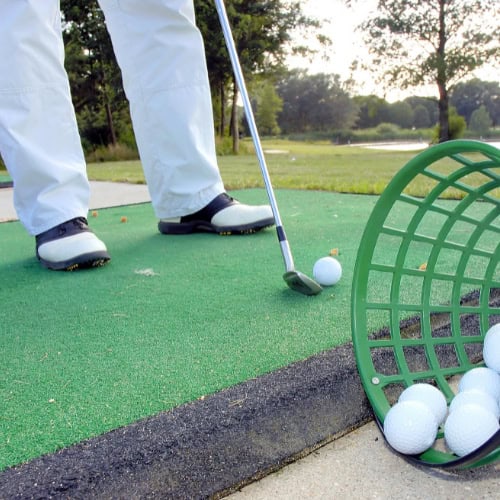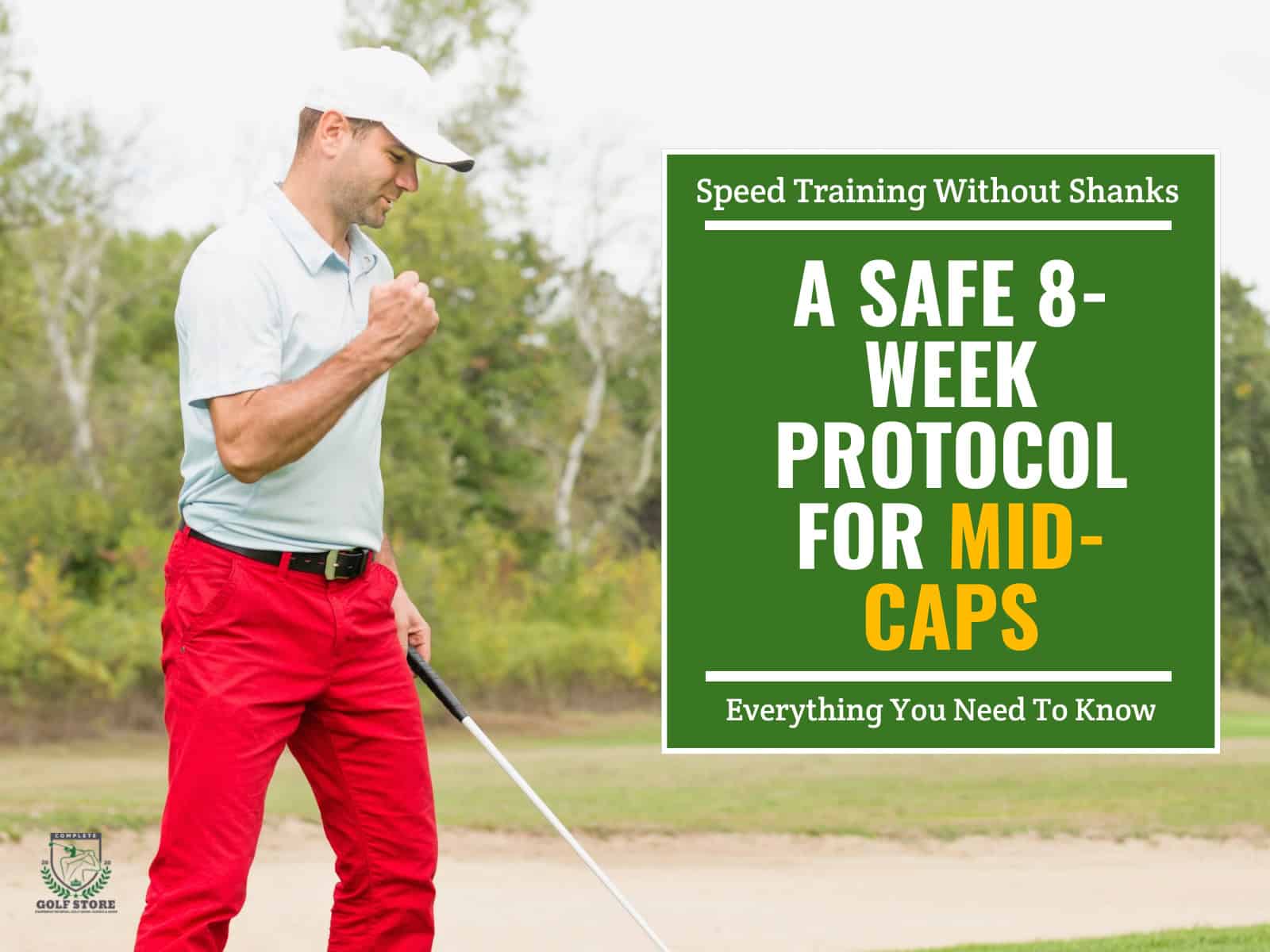Golfers wrestle with a simple question: should you spend more time grinding at the driving range or playing full rounds on the course? The answer isn’t one or the other. Both sharpen different edges of your game.
Think of the range as your workshop, where you can hammer away at mechanics without distraction. The course, on the other hand, is your proving ground, with uneven lies, wind gusts and pressure all waiting to test you.
Here, you’ll see what each setting can and can’t teach you. You’ll also get sample weeks that balance skill-building with real play so you know exactly how to split your time and start lowering scores.
- 1) Range vs. Course: Quick Answer to “Where Should I Practice?”
- 2) What the Driving Range Can Teach You (and What It Can’t)
- 3) What the Golf Course Can Teach You (and What It Can’t)
- 4) The Right Balance for Beginners (Range vs. Course Practice)
- 5) Sample Weekly Golf Improvement Plans
-
6)
Frequently Asked Questions
- 6.1) How many balls should a beginner hit per range session to avoid fatigue and bad habits?
- 6.2) Are par-3 or executive courses a better first step than jumping straight to full 18-hole rounds?
- 6.3) Do range balls fly differently enough to change my distances on the course?
- 6.4) Is simulator practice a good substitute when I can’t get to the course, and how should I adjust?
- 6.5) What’s an easy way to track progress without getting lost in stats?
- 6.6) If I only have 45–60 minutes, should I choose the range or play a few holes, and why?
- 6.7) What’s a reasonable consistency benchmark before I start scheduling regular full rounds?
- 7) Final Thoughts
Range vs. Course: Quick Answer to “Where Should I Practice?”
When you want repetition, the driving range is your best friend. Buckets of balls let you hammer away at grip, stance and tempo until the swing feels automatic. It’s cheap, quick and you can focus on one thing without distractions.
But when it comes to learning how to score, the golf course wins every time. Out there, you face uneven lies, tricky winds and the pressure of real shots that count. No mat or bucket can teach you how to think through a hole or recover from a mistake.
The smartest play is to use both. Spot weaknesses while playing, then fix them on the range. Once the swing feels solid, take it back onto the course and see if it holds up under real pressure.
What the Driving Range Can Teach You (and What It Can’t)
The driving range is where you sharpen the blade before stepping onto the battlefield. It offers repetition, control and space to refine your swing without pressure. But while it builds strong foundations, it leaves some holes that only the course can fill.

Mechanics and Repetition for Consistency
On the range, you control the setting. Every ball sits on a flat lie, and you can reset after each swing. This makes it the perfect place to groove fundamentals like grip, stance, alignment, and ball position.
Repetition builds muscle memory. You can hit dozens of balls with the same club until the move feels automatic.
Shot-Specific Skill Work
The range also lets you focus on different parts of your bag. If you want to sharpen wedge distance, you can hit ten shots to a 50-yard target, then adjust and repeat. Need to practice long irons or hybrids? The range gives you space to work on launch and contact. With a driver, you can experiment with tempo and balance without worrying about losing balls or slowing down play.
Built-In Limits of Range Practice
The range hides the truth of the game. You never face uphill lies, thick rough or wind swirling across a fairway. Mats can forgive fat shots, and range balls rarely fly the same as those in your bag.
There’s also no scoreboard or penalty for a poor swing. That lack of consequence makes practice comfortable, but it can trick you into thinking you’re ready when the course will say otherwise.
To bridge this gap, you need effective golf transfer drills from range to course that can help make your practice more applicable to real-world conditions. These drills focus on translating what you’ve worked on at the range into tangible results on the course, ensuring that your skills hold up when it counts the most.
What the Golf Course Can Teach You (and What It Can’t)
On the course, every shot carries weight. Unlike the range, you don’t get a redo without a penalty. That shift changes everything; suddenly, each swing demands attention, patience and a clear head.

Real-Game Conditions and Decisions
One of the biggest adjustments golfers face on the course is handling lies that aren’t flat. Sidehill, uphill, and downhill stances demand changes in ball position, balance, and club choice. Mastering an uneven lies golf setup ensures you can adapt your swing to these real-world conditions and avoid wasting strokes.
Every hole is a puzzle. You weigh the safe play against the hero shot. You judge wind, slopes and hazards. You learn which club works when the ground isn’t flat and the stakes are high.
That kind of decision-making can’t be rehearsed on a mat.
Mental Game Under Pressure
Golf on the course tests your nerves. A short putt for par feels different when friends are watching or a good round is on the line. Staying calm, trusting your swing and accepting mistakes builds the mental muscle you’ll need for steady scores.
Built-In Limits of Course Play
But the course has its own limits. You won’t hit enough shots to groove mechanics. If your swing is off, you can’t stop mid-round to fix it.
Each mistake is recorded, and feedback is slower to process. It’s a proving ground, not a workshop, and that’s exactly why it matters.
The Right Balance for Beginners (Range vs. Course Practice)

Finding balance isn’t about splitting time 50/50. It’s about knowing when you need volume and when you need pressure. The mix shifts as your swing steadies and your confidence grows.
Simple, Beginner-Friendly Ratio
Early on, you’ll get more out of the range. Use it when you’re fixing grip, posture or contact. Once you can hit the ball forward most of the time, start mixing in more rounds. A good rule is two or three range sessions for every round, then slowly flip the ratio as you improve.
When to Bias One Side
Bias range if the ball isn’t leaving the clubface the way you want. That’s where you drill until contact and direction stabilize.
Bias course if your swing holds up but your scorecard shows poor choices. Course time teaches you how to manage holes, not just swings.
Budget/Time Realities and Easy Progression
Life doesn’t always leave space for 18 holes. Par-3 or executive tracks are cheaper and faster, giving you real-game reps without a five-hour block.
If time’s tight, play a handful of holes after work or focus on short-game practice. Small, focused bursts beat long, aimless sessions, and they keep you hungry for the next step.
One of the best ways to maximize limited practice windows is with a structured 30-minute short game practice routine. Focused wedge and putting circuits sharpen scoring skills quickly and fit neatly into busy schedules.
Sample Weekly Golf Improvement Plans

You don’t need a complicated calendar to get better. What you need is a simple structure you can repeat and adjust as your game grows. Think of these weeks as templates, not strict orders.
Skill-Building Week (Range-Heavy)
- Day 1: Mechanics block with setup and tempo drills, then wedge shots to set targets.
- Day 2: Long clubs like hybrids and driver, always hitting toward specific markers.
- Day 3: Short-game hour: chips, pitches and putts.
- Day 4: Light range work to maintain feel, followed by a 9-hole test on the course.
- Day 5: Review notes from the week and finish with a short tune-up session.
Play-Focused Week (Course-Heavy)
- Day 1: Play 9–18 holes with an emphasis on safe, conservative choices.
- Day 2: Practice greenside shots and lag putting.
- Day 3: Another 9 holes, keeping simple targets and recording misses.
- Day 4: Short range session to iron out issues noticed on the course.
Two-Week Rotation for New Golfers
Pair the two templates back-to-back. Week A leans on technique and range time. Week B shifts to more play and scoring focus. After each cycle, look at what improved and what still needs work; you’ll start spotting patterns you didn’t expect.
Frequently Asked Questions
Every new golfer wrestles with the same concerns: how much to practice, when to play and what tools actually matter. With these answers, we’ll help you focus on what moves the needle.
How many balls should a beginner hit per range session to avoid fatigue and bad habits?
Aim for 50–70 quality swings. Any more and your form breaks down. Stop the session the moment you feel yourself getting sloppy.
Are par-3 or executive courses a better first step than jumping straight to full 18-hole rounds?
Yes. They let you practice scoring and short-game skills without the time and pressure of a full track. It’s the best bridge from range to course.
Do range balls fly differently enough to change my distances on the course?
They do. Range balls are built for durability, not accuracy. Expect them to fly shorter and sometimes straighter than your gamer balls. Always confirm yardages on the course.
Is simulator practice a good substitute when I can’t get to the course, and how should I adjust?
Golf simulators are useful for swing data and repetition. Just remember they lack pressure and uneven lies. Treat them more like range practice, not a full replacement for rounds.
For a deeper comparison of golf simulators vs the driving range, check out this article on the pros and cons of each approach.
What’s an easy way to track progress without getting lost in stats?
Keep a simple notebook. Write down fairways hit, greens in regulation and putts. Over time, patterns jump off the page without fancy numbers.
If I only have 45–60 minutes, should I choose the range or play a few holes, and why?
Choose a few holes if possible. Real shots under pressure teach more than banging balls. If daylight or access is tight, use the range but set clear goals.
What’s a reasonable consistency benchmark before I start scheduling regular full rounds?
If 7 out of 10 shots leave the club in the right direction, you’re ready. Perfection isn’t the goal; steady progress under pressure is.
Final Thoughts
Golf isn’t mastered in one place. The range builds your swing, but the course teaches you to score. You need both, and the trick is blending them in a way that fits your time and goals.
Think of the range as rehearsal. It’s where you can take 20 swings at the same shot until it feels second nature. Then step onto the course and let those habits face real-world pressure. That back-and-forth rhythm—practice, test, adjust—creates steady progress.
For beginners, alternating between range-heavy weeks and play-focused weeks works best. The routine keeps you from hiding in comfort zones. Too much range and you never learn strategy. Too much course and you never fix flaws.
If you stick to that balance, you’ll see strokes fall off your scorecard and start asking a bigger question: what’s possible next?





